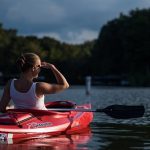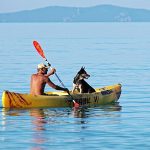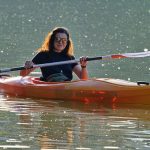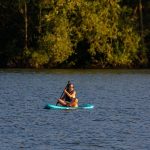The main difference between the two types of kayaks is that sit-on-top kayaks have an open deck, while sit-in kayaks have a closed deck. Sit-on-top kayaks are more stable and easier to get in and out of, while sit-in kayaks are more efficient in the water.
A sit-in kayak is better for cold or rough water, touring, surfing, and paddling long distances, while a sit-on-top kayak is better for beginners, summer, learning, cooling off, and getting in and out of your kayak.
Pros and cons of sit-in vs sit-on kayaks
Benefits and Drawbacks of a Sit-In Kayak
A sit-in kayak is a kayak in which you sit inside a cockpit. This may seem like the best option for a beginner, but it may actually be the opposite.
Even though sit-in kayaks are designed to protect your lower body from the cold winds and water, you still need to be aware of some safety concerns when using them.
Since you sit inside the kayak in this position, you may feel more confined than usual. The cockpit will not give you a lot of room to move around while you are paddling. Another downside to this position is that if you were to flip over while in the water, the inside of the kayak will fill with water and make it hard for you to paddle. Also, you will get wet if you capsize.
You will not be able to continue or even go back to shore to dry off before you bilge pump the water out of the cockpit. This is a task for more experienced kayakers. You should know how to do it and/or practice before you get too far from shore with a sit-in kayak.
Sit-in kayaks are more difficult to get back into if you fall out in open water.
Benefits and Drawbacks of a Sit On Top Kayak
A sit-on-top kayak does not have a cockpit for the lower body like a sit-in kayak does. Instead, there is a molded-in cutout seat and footrest area on top of the kayak. This type of kayak may be a better choice for beginners or for people that are looking for more space while they learn the basics of kayaking.
If you’re nervous about learning to paddle a kayak, are a beginner, or are taking your kids kayaking for the first time, then a sit-on-top kayak is a great option.
A sit-on kayak is good for beginners because it is more stable and gives them more space to move. The kayak has scupper holes which let water in and out, so it doesn’t fill up with water.
A sit-on kayak has no sheltered space, so you will get wet when paddling and during kayaking. So, if you don’t want to get wet, you may want to get a recreational sit-in kayak that has a wider cockpit opening.
Comparison of sit-on vs sit-in kayaks
Sit-on-top vs sit-in kayak stability
Stability in a kayak is largely determined by its width, with wider kayaks being more stable. This is true for both sit-inside and sit-on-top kayaks. However, there are other factors that can affect stability.
The higher the seat is in a kayak, the less stable it is. This is because seats that are mounted high above the waterline decrease stability. Fishing kayaks often have seats that are mounted higher off the water so that people can cast better.
This means that fishing kayaks have to be wider or fuller at the ends to have the same stability as other kayaks.
The “fullness in the ends” of a kayak is referring to how wide the kayak is from the front to the back. A kayak that is more box-shaped will be more stable than one that is more diamond-shaped.
Sit-inside touring kayaks may not be as stable as recreational kayaks, but there are plenty of options available that offer enough stability to make anyone comfortable while paddling.
Design
The three main factors that determine how a boat will perform are length, width, and rocker.
A longer boat will usually be faster than a shorter boat, all other things being equal. This is because a shorter boat has less space for a motor or paddles, so it can’t move through the water as easily.
If everything else is the same, a shorter boat will be easier to turn than a longer boat. For example, small, recreational kayaks turn very quickly, but longer kayaks are faster, even though they take longer to turn.
A kayak with more rocker will be easier to turn than a kayak with less rocker. Rocker is the curve of the hull as it runs from the bow to the stern of the boat. If you set a kayak on the ground, you can easily see the rocker—the bow and stern of highly rockered boats won’t touch the ground.
A boat without rocker will touch the ground from the bow to the stern.
Designers have to balance the amount of rocker on a boat depending on what it will be used for. Too much rocker makes the boat harder to turn, but also makes it slower.
The wider the boat, the more stable it is. Narrower boats require less effort to move through the water but are less stable. Designs that are fuller towards the end are more stable, but are slower than designs with sharper ends.
As mentioned before, width and fullness must be balanced with the height of the seat to ensure stability. Fishing sit-on-top designs with high seats are typically wider and have fuller ends than sit-inside recreational kayaks with seats mounted closer to the waterline.
Performance
In general, when people discuss performance in terms of kayaks, they are referring to speed. As we discussed previously, speed is mainly determined by a kayak’s length and width.
A longer and narrower kayak will be faster than a shorter and wider kayak, regardless of the kayak’s sit-on-top or sit-inside design.
Typically, shorter kayaks are much slower than longer ones. This is because they have more resistance when moving through the water. Longer kayaks require less effort to move, so it is best to start with a kayak that is around 12 feet long if you are looking for a versatile recreational kayak.
There is a limit to how much longer a kayak can be because it starts to offset the gain in speed. In most cases, the kayak cannot be longer than 18 or 19 feet because it becomes more difficult to maneuver.
Function
Sit-in or sit-on kayaks for beginners
It is difficult to say which style of kayak is better for beginners. Some might prefer a stable kayak that is easy to paddle, whether it is a sit-on-top or sit-inside design.
When looking for a kayak as a beginner, it is better to consider what your goals are for using the kayak and what design would be better for that purpose.
For example, someone interested in kayak camping would choose a different design than someone focused on kayak fishing.
Sit-in or sit-on kayaks for ocean
For kayaking in areas where you are far from shore, sit-on-top models are better because they won’t fill with water if you capsize and they are easy to climb back onto if you fall off.
Sit-inside kayaks with large cockpits and limited floatation are not good for paddling on the ocean because they can tip over easily.
Sit-inside kayaks designed for touring are narrower and less stable than recreational kayaks, but they have bulkheads that limit how much water can enter the cockpit if the kayak capsizes. These bulkheads also create large floatation chambers that keep the kayak afloat even if it is swamped.
Choose a sit-inside touring kayak for open water paddling only if you’re willing to learn some rescue skills in case you flip over.
Sit-on-top vs sit-in kayak for fishing
Most fishing kayaks have an open deck, which gives the paddler better mobility for casting, fighting, and landing fish than a closed-cockpit design. Wide, stable fishing kayaks are designed with standing platforms, and some models feature pedal drives that allow you to keep both hands free for fishing.
With all these features, fishing kayaks have the edge when it comes to fishing.
Some people who fish prefer to do so from a sit-inside kayak, which offers better protection against the elements than a sit-on-top kayak. However, some kayaks have features that make them difficult to distinguish from canoes, while others have features that make them difficult to distinguish from sit-on-top kayaks.
When fishing in cold weather, kayakers who want to stay dry and warm may prefer a sit-inside kayak. Alternatively, kayakers who already have a sit-inside recreational kayak may decide to add fishing accessories to it rather than purchasing a new sit-on-top kayak specifically for fishing.
Sit-in vs sit-on kayaks for tandem paddling
There is no one design of tandem kayak that is better than the others. The best kayak for you to paddle depends on what kind of paddling you want to do. If you want to paddle a long distance from shore, you should get a sit-on-top kayak.
If you only want to paddle in shallow water, you should get a sit-inside kayak. If you want to camp out of your kayak, you should get a tandem touring kayak.
Having the paddlers sit close together in a tandem kayak will improve performance because they will need to synchronize their paddle strokes to avoid hitting each other’s paddles in the air.
Some larger tandem touring kayaks have a hatch between the two cockpits so that the paddlers don’t have to paddle in sync.
Conclusion
Both kayak styles are good for their intended purposes.
The kayak you choose should be based on your goals and aspirations as a paddler.
If you’re just starting out, I would recommend getting a sit-on kayak first and practicing with it for a summer before deciding if you want to get a sit-in kayak. Sit-on kayaks are much easier to learn the basics of paddling from. Additionally, sit-on-top kayaks are much more comfortable than sit-in kayaks.
If you want to go on longer trips and explore bigger bodies of water, then a sit-in kayak might be a good option for you. With a sit-inside kayak, you’ll be able to paddle faster and for a longer distance.
If you want to go on multi-day trips on the open water, you should look at touring or sea kayak designs that have storage and floatation. If you like fishing, you should probably consider a sit-on-top fishing design.
Choose a boat that is best suited for the conditions you will mostly encounter, with some consideration given to the trip you hope to take in the future.
You should only do physical activities that you are comfortable with and that you know the basics of. You should never do something without knowing how it works, especially if it could be dangerous.
Most importantly, be cautious and go at your own pace while you improve your paddling skills.



